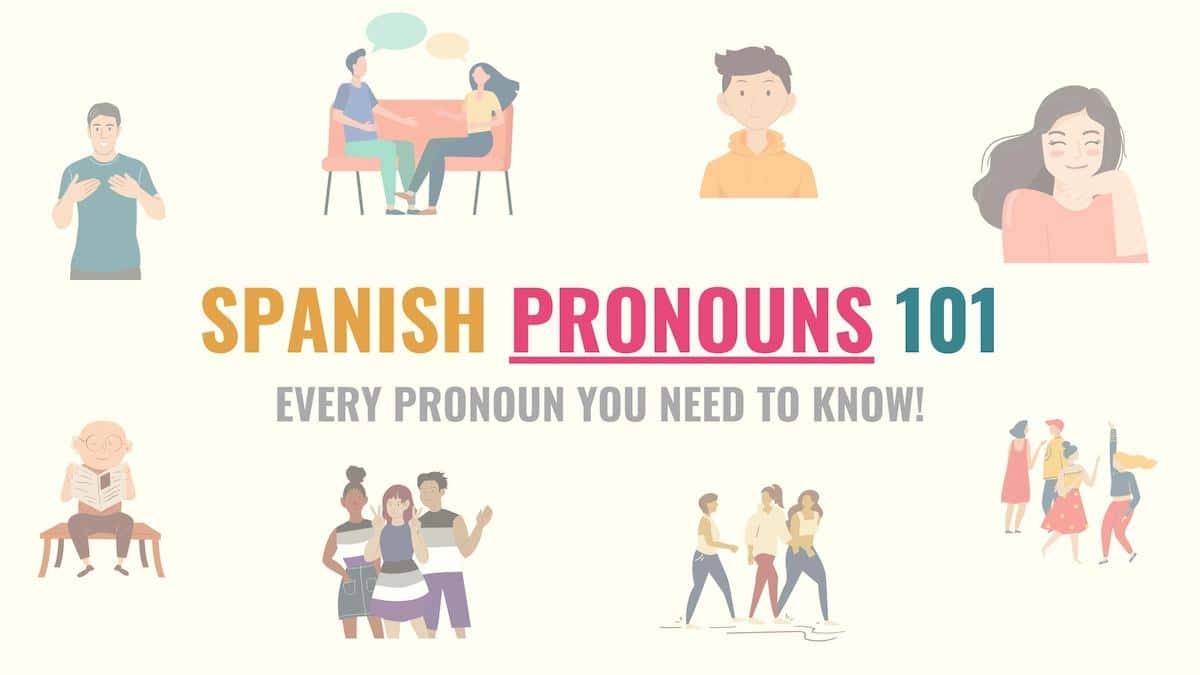Key Points
Spanish pronouns are an essential part of any language. This is because they replace a noun without altering the meaning or impacting the coherence of a sentence. Here are some key points you must remember about pronouns in Spanish:
- Spanish personal pronouns mark the number and gender of a noun most of the time.
- Personal pronouns in Spanish replace people and things.
- There are different types of pronouns because a noun can have different functions within a sentence.
- Subject pronouns replace the subject of a sentence.
- Reflexive pronouns are a crucial part of pronominal verbs.
- Spanish prepositional pronouns are pronouns used after a preposition.
- Except for the first and second singular person, prepositional pronouns are the same as subject pronouns.
- Spanish direct object pronouns replace the noun that receives the action of the verb.
- Indirect object pronouns in Spanish express who benefits or is affected by the action.
- Demonstrative pronouns express the distance between the speaker and the noun being replaced.
- Spanish relative pronouns combine two sentences that refer to the same noun.
- Possessive pronouns in Spanish are used to talk about possessions and belongings.
Spanish pronouns are fundamental for communicating. Do you know why? Because these words allow you to shorten sentences while clarifying who or what you’re talking about. So, in short, pronouns are essential when learning Spanish.
But since pronouns vary depending on their function within a sentence, many people confuse these words or have issues using them. For that reason, in this guide, you’ll learn all the pronouns in Spanish (including all personal pronouns) and how to use them.
The topics we’ll cover include:
- Key Points
- Subject Pronouns
- Reflexive Pronouns
- Prepositional Pronouns
- Direct Object Pronouns
- Indirect Object Pronouns
- Relative Pronouns
- Possessive Pronouns
- Demonstrative Pronouns
- Downloadable PDF Cheat sheets
Before we jump in, the first thing to know is that most of these different types of pronouns fall into a larger category, called personal pronouns. As we go through this guide, I’ll point out which are not personal pronouns and explain why.
Take Note: Thinking that a Spanish personal pronoun only replaces a person is a common misconception. They also replace things! They are called personal pronouns because they match the number and gender of the noun which they’re replacing.
Spanish Subject Pronouns
Subject pronouns in Spanish replace the subject of a sentence. In other words, these pronouns replace the person or thing that performs the action.
Spanish subject pronouns in Spanish are:
- Yo – I
- Tú – You (informal)
- Él – He
- Ella – She
- Usted – You (formal)
- Nosotros / Nosotras – We
- Vosotros / Vosotras (Spain/Castilian Spanish only) – You (plural)
- Ellos / Ellas – They
- Ustedes – You (formal)
Here are some examples:
Yo soy mexicana.
I’m Mexican.
Ella es mi prima.
She is my cousin.
¿Ustedes de dónde son?
Where are you from?
Spanish conjugations have different endings for each subject pronoun. So, unlike English, subject pronouns in Spanish can usually be omitted because the conjugation often indicates who the subject is.
Take Note: Notice that Spanish has a formal and informal ‘you’. Although they have the same translation, these pronouns are applied in different contexts.
Reflexive Pronouns
Reflexive pronouns in Spanish are used when conjugating pronominal verbs (verbs that end in -se), such as reflexive verbs. We use reflexives to talk about actions that people perform on themselves.
Spanish reflexive pronouns are:
- Me: I / Myself
- Te: You / Yourself
- Se: He – Himself / She – Herself
- Nos: We / Ourselves
- Os: You / Yourselves
- Se: You – Yourselves / They – Themselves
As you’ll see in the examples below, reflexive pronouns in Spanish can be translated into English by using a subject pronoun.
¿Cómo te llamas?
What’s your name?
Ellos se despiertan temprano.
They wake up early.
Ayer me despedí de Brenda.
I said goodbye to Brenda yesterday.
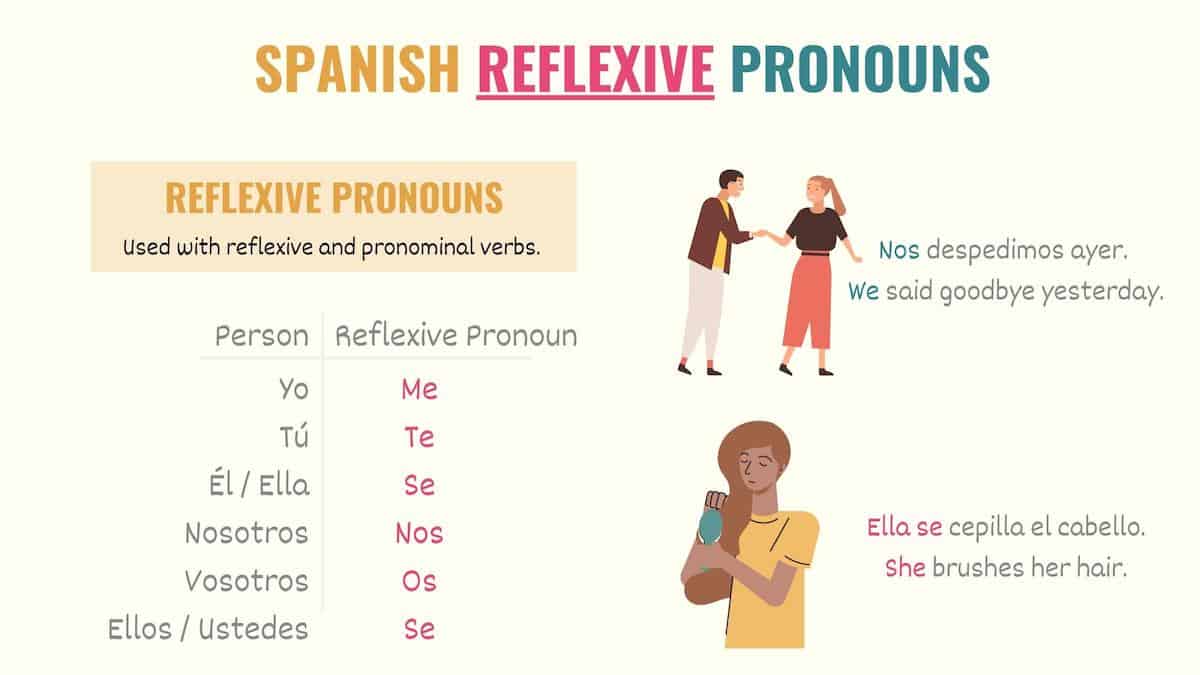
Tip: Reflexive verbs are a common type of pronominal verb. However, not all pronominal verbs are reflexive. Sometimes, a pronominal verb may have a different meaning than its standard counterpart —for example, despedir (to fire) vs despedirse (to say goodbye).
Spanish Prepositional Pronouns
In Spanish, prepositional pronouns are pronouns we use after a preposition. Mostly, these pronouns are the same as subject pronouns. Below is a list of the prepositional pronouns in Spanish:
- Mí* – Me
- Ti* – You
- Él – Him
- Ella – Her
- Nosotros – Us
- Vosotros – You
- Ustedes – You
- Ellos / Ellas – Them
*Mí and ti are the equivalents of ‘yo’ and ‘tú’, respectively. However, they take this irregular form with most prepositions. Notice that ‘mí’ and ‘ti’ become one single word when used with the preposition con.
¿Esto es para mí?
Is this for me?
Ve con ella.
Go with her.
Yo voy contigo.
I’ll go with you.
Tip: Mí and ti are used with most prepositions except entre, incluso, según, menos, and excepto. When using those specific prepositions, use yo and tú instead.
Direct Object Pronouns
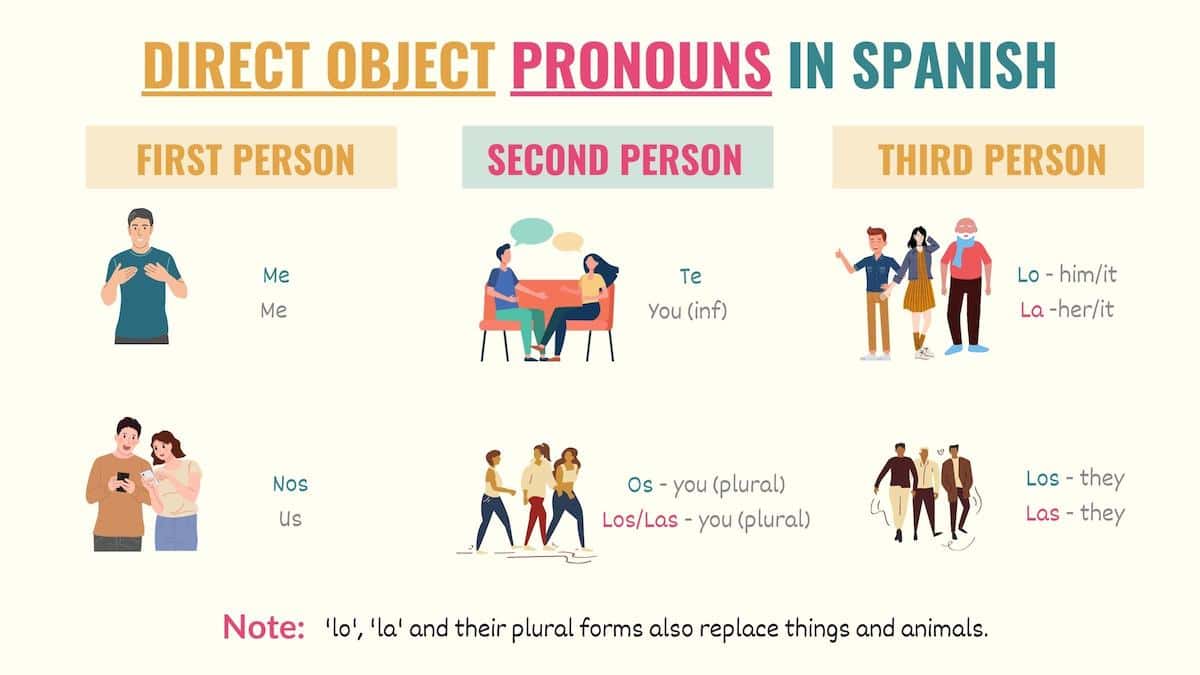
Spanish direct object pronouns replace a direct object. In other words, these pronouns replace the noun that receives the action of a verb. As a tip, direct objects are the elements closer to the verb.
Direct object pronouns in Spanish are:
- Me: Me
- Te: You
- Lo: Him / It (masculine)
- La: Her / It (feminine)
- Nos: Us
- Os: You
- Los / Las: Them
Below are some examples of how to use these words. Notice that Spanish direct object pronouns replace both people and things.
Sentences marking the direct object:
- Carlos vio la película. – Carlos watched the movie.
- Invité a mis primos. – I invited my cousins.
- Ya encontré mi celular. – I already found my cell phone.
Carlos la vio.
Carlos watched it.
Los invité.
I invited them.
Ya lo encontré.
I already found it.
Take Note: Object pronouns are placed before the conjugated verb in Spanish. Also, notice that because you must mark the gender of a noun, ‘it’ has a masculine and feminine form.
Spanish Indirect Object Pronouns
Indirect objects express for whom or to whom the action is done. In other words, indirect object pronouns in Spanish replace the thing or person who benefits or is affected by the action. Below is a list of all indirect object pronouns:
- Me: Me
- Te: You
- Le / Se: Him / Her / It
- Nos: Us
- Os: You
- Les / Se: Them
Take Note: Some articles may translate indirect articles as to me, to you, etc. This is because, in some sentences, indirect objects may be preceded by a preposition.
Here are some examples of sentences using Spanish indirect object pronouns:
Sentences with an indirect object:
- Compré unas flores para Dennis. – I bought some flowers for Dennis.
- Hago galletas para los niños. – I’m making cookies for the kids.
- Carlos mandó esto para ti. – Carlos sent this for you.
Le compré unas flores.
I bought him some flowers.
Les hago galletas.
I made them cookies.
Carlos te mandó esto.
Carlos sent you this.
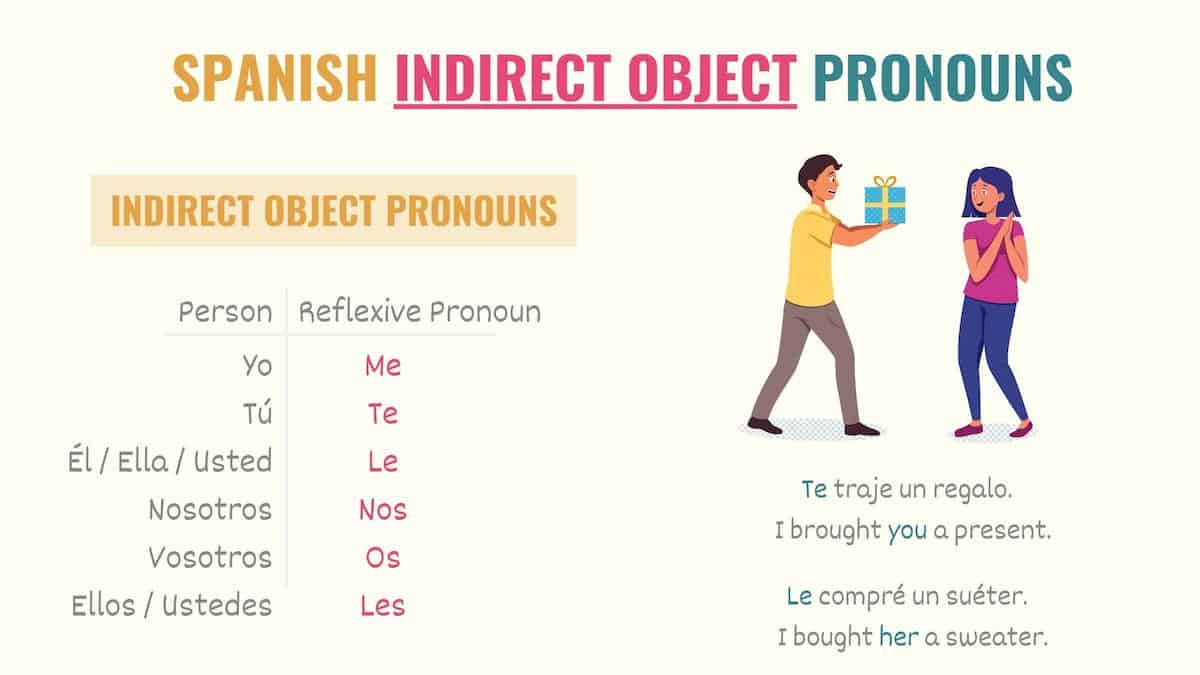
Take Note: If a sentence contains both direct and indirect objects, the indirect object pronoun le must be replaced by the double object pronoun se to ease the pronunciation. In addition to being an indirect and reflexive pronoun, the Spanish pronoun ‘se’ has other applications.
Relative Pronouns
Spanish relative pronouns help you connect and combine sentences that have a noun in common. From a grammatical point of view, relative pronouns are the bridge that connect a main clause with a subordinate clause.
Relative pronouns in Spanish include:
- Que: that / who / whom
- Quien: who / whom
- Cuyo: whose
- El cual: which
- La cual: which
- Lo que / Lo cual: which / what
El señor que vende fruta es mi tío.
The man who sells fruit is my uncle.
Sandra y Aaron, a quienes vimos ayer, se casaron.
Sandra and Aaron, who we saw yesterday, got married.
Me dijo que no iba a venir, lo cual no tiene sentido.
She told me she wouldn’t come, which doesn’t make sense.
Possessive Pronouns in Spanish
As its name suggests, Spanish possessive pronouns are used to talk about possessions and belongings. Although you may use them to replace people, possessive pronouns are more commonly used to refer to things.
The Spanish possessive pronouns are:
- Mío(s) / Mía(s): Mine
- Tuyo(s) / Tuya(s): Yours
- Suyo(s) / Suya(s): His / Hers / Yours (formal)
- Nuestro(s) / Nuestra(s): Ours
- Vuestro(s) / Vuestra(s): Yours (Spain)
- Suyo(s) / Suya(s): Yours / Theirs
Here are some examples of how to use these pronouns:
Disculpa, ¿esto es tuyo?
Excuse me, is this yours?
No, no es mía. Creo que es de Lily.
No, it’s not mine. I think it’s Lily’s
Esta es copia se queda y esta es suya.
This copy stays here, and this is yours.
Spanish Demonstrative Pronouns
Demonstrative pronouns in Spanish express the distance between the speaker and the noun you are replacing.
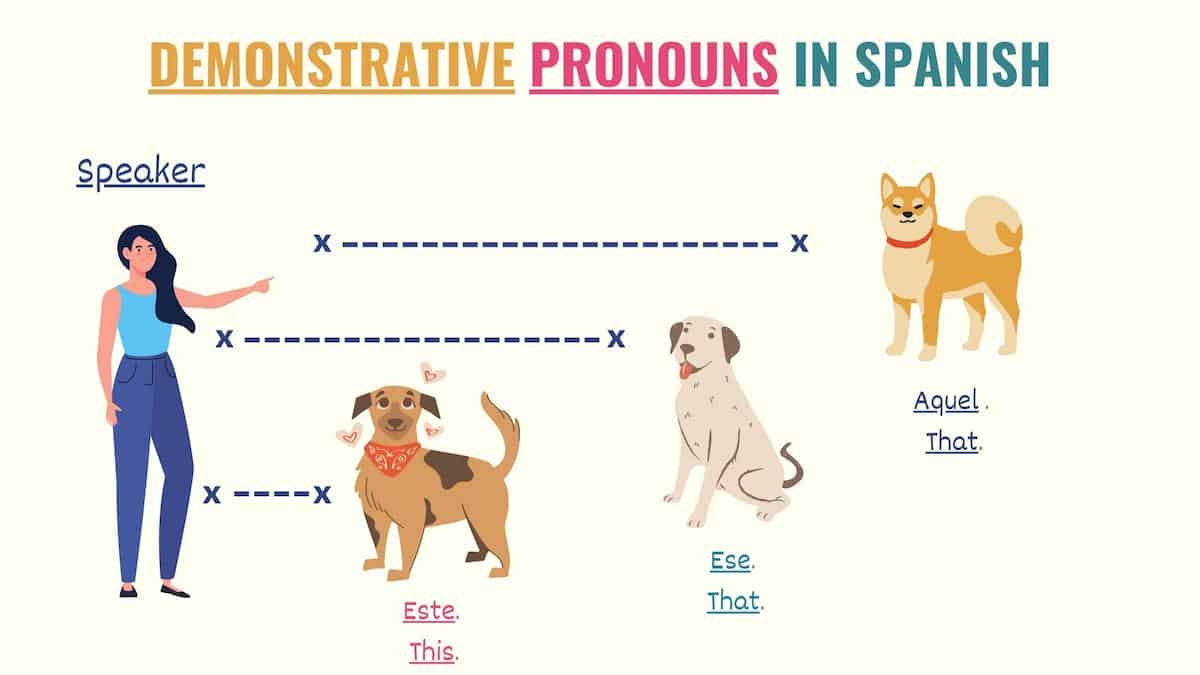
Demonstrative pronouns are:
- Este(s) – This / These (masculine)
- Esta(s) – This / These (feminine)
- Ese(s) – That / Those (masculine)
- Esa(s) – That / Those (feminine)
- Aquel / Aquellos – That / Those (masculine)
- Aquella(s) – That / Those (feminine)
Notice that the plural form of demonstrative pronouns is formed by simply adding an s to the end of the pronoun. The one exception being ‘aquel’, whose plural form is ‘aquellos’.
¿Qué es eso?
What is that?
Toma este lugar, aquellos están ocupados.
Take this seat; those are occupied.
Esta blusa es bonita, pero prefiero esta.
That blouse is pretty, but I prefer this.
Download the Spanish Pronouns Cheat Sheets
While I hope I’ve made Spanish pronouns as simple as possible for you to understand, you’ll likely need to revisit this topic numerous times as you learn Spanish. Please feel free to download a copy of the pronouns cheat sheets PDF so you can refer back to it whenever you need to!

